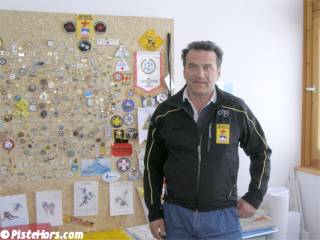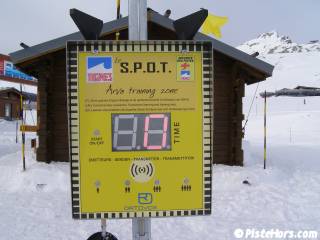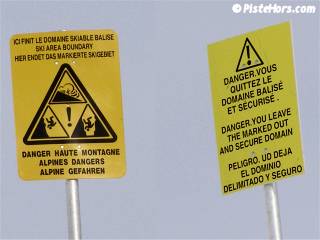Just found this article and very interesting thanks. Quite like the comment “you have to understand the french” from a frenchman.

In mid January we travelled to the ski resort of Tignes to interview Jean-Louis Tuaillon, the director of piste security. Over the last couple of seasons there have been 10 avalanche fatalities in the off-piste areas of the Espace Killy (Tignes + Val d’Isère) including the death of two British snowboarders on the Grande Motte at the end of last season. This winter started badly when a British medical student was caught in an avalanche close to the ski slopes before Christmas. We wanted to find out what the resort was doing to address security both on and off the pistes. M. Tuaillon is friendly but a straight talker, read what he has to say.

Jean-Louis Tuaillon, director of Tignes piste security
PH: First lets talk about the ski runs themselves. How many accidents are there on the slopes?
JLT: Around 1600 to 1700 evacuations per year; 93% due to falls and 5% due to collisions. Collisions are more serious and the figure has increased due to the developments in equipment and the different lines taken by skiers, carvers and snowboarders. This same equipment has also made it much easier to leave the open ski runs.
PH: Should people wear protection?
JLT: I could mandate that everyone must wear a helmet on the slopes but if that means they go on average 10km/h faster with only 75% of the field of view then things might get worse. For me it is a question of attitude and education rather than regulation. People have to understand they are in the high mountains not a funfair ride.
PH : We noticed a lot of chicanes at the bottom of runs and at crossings points.
JLT: A couple of years ago we did a study to define the cause and localize accidents and we made improvements. Now if there are say 3 accidents in the same area we do something directly.
PH: The Espace Killy has a reputation as an off-piste mecca. Do you know how many visitors leave the marked slopes?
JLT: It is difficult to estimate. The police have taken aerial photographs and say it is around 10-12% but we have made surveys and the figure is much higher, closer to 50% of our visitors who do some off-piste.
PH: What are we talking about exactly when we say “off-piste”?
JLT: If you are outside the piste markers you are off-piste. These days people can go off piste very easily, sometimes without really appreciating that they have left the marked slopes. When there are tracks everywhere it is not always easy to understand the difference.
PH: You have had 10 avalanche deaths in the Espace Killy over the last two seasons, 6 of them in Tignes, what can you do to reduce the number of avalanche accidents?
JLT: In the mid-90s we did a lot of work improving piste security and creating a standard for French ski resorts. This is very strict, it talks about piste markings, signs etc but doesn’t talk about off-piste. Today maybe 3,000 skiers and snowboarders take the popular Vallons de la Sache off piste route in a single day. Should I continue to turn a blind eye to what people are doing off-piste? Things have evolved and my approach today is to help people learn about the mountain environment.
PH: What message would you like to get across to visitors ?
JLT: If you come to Tignes, or Val d’Isère with the idea of doing some off-piste then visit the Freeride hut and talk to the piste patrol. There are lots of patrollers who speak English. We have an exchange program with America and Australia and this year I’ve employed an English patroller so there is always the possibility of having information.
The problem for someone living in say, London, is that over the course of the season the snowpack evolves. If someone comes at Christmas and returns at Easter it is not the same snow.

Beacon training park, Tignes
PH: What role does the Le SPOT (Skiing Powder of Tignes) freeride area play?
JLT: It is a small thing but what we want to tell people is when you arrive at the bottom of a ski lift: open your eyes; you are going into the mountains not Disneyland. We explain about the environment, where there are dangers such as cliffs, where there might be at risk of avalanches given the current avalanche bulletin, the information is there, make use of it. On the ski slopes we try to address the dangers; off piste it is up to you to take care and ski responsibly.
PH : Are there any restrictions to off piste skiing in the ski domain?
JLT : No there are no restrictions, the patrollers are there to advise and help people.
PH : In some resorts (la Mongie, Auron, Montgenèvre) the mayor has passed a bye-law banning off-piste skiing when the avalanche risk is above 2.
JLT: The problem with that is it is impossible to enforce even if all the local police, patrollers and liftmen do only that. It is just not possible. In 1999, after a series of accidents such as Montroc, the Prefet of the Haute-Savoie (M. Breuil) tried to ban off-piste skiing. The first who protested were the Chamonix guides. If tomorrow I decided to ban off-piste skiing it would be impossible for me to enforce. If an area is dangerous the only solution I have is to close the ski lift serving the sector.
PH : You could still access it with touring skis ?
JLT: You are talking about alpinists, climbers. If the lift is open then I have to make sure the runs are safe.
PH : You have said in the past that many skiers and snowboarders don’t understand the avalanche flags?
JLT: Yes, maybe the system used in some countries where a series of colours: green, yellow, orange, red, black corresponding directly with the 5 levels of avalanche risk is easier to understand than our system? But my colleagues don’t all agree. You know, there are 50% of visitors who don’t even realize there is an avalanche flag.

Avalanche warning flags
PH : In Zinal (Switzerland) they have put in place gates where you can only pass if your avalanche beacon is transmitting. Have you thought about adopting that system at Tignes at certain itineraries such as the Vallons de la Sache?
JLT: No. At Zinal I believe they close the gates when the risk is 3 (considerable) or more. In the US they do the same with access to the outbounds skiing. It is very American, there is a gate and lots of disclaimers to read. That is not how you educate and make people responsible enough to take their own decisions. You also have to understand the French. If there is a gate and fence they will climb over it.
I don’t want to build a Berlin wall at Tignes and in any case you can’t say that it is safe when the avalanche risk falls below a particular level. I know that today I could ski a certain run myself but I can’t explain to 5,000 other skiers why I passed behind a bump or in front of a rock. What I can do is try to be like an older brother rather than a cop and say learn to appreciate the conditions and make decisions yourselves.
PH : Are you worried about people skiing off-piste above open runs ?
JLT: As a general rule the slopes above open pistes are avalanche controlled otherwise the run is closed.
PH : So the open run should be safe but not necessarily the slope itself ?
JLT: Yes
PH : In the US they have the idea of inbound off-piste where all slopes are controlled for avalanches, can you do that here?
JLT: In France avalanche control is authorized only to secure open runs, road and also ski lifts but not buildings with certain exceptions. We are not allowed to control a popular off-piste run such as the Sache.
PH: What methods do you use for controlling avalanches?
JLT : Gaz-ex, Catex, manual, helicopter, we use every technique at Tignes.

Entrance to the couloir du Chardonnay at Tignes
PH : A patroller was killed at Tignes in February 2002 during avalanche control. Since then you have equipped all the patrollers with the ABS Airbag system ?
JLT: We decided to do that three years ago. You know, the ABS Airbag, it might seem odd, but I’m against it because I say you should never put yourself in a situation where you need it. Still, maybe a couple of times in the course of a winter one finds oneself in such a situation, not just during avalanche control work but maybe when we have to rescue someone off-piste. So I have said that everyone must use the ABS all of time even when the avalanche risk is 1. It is like wearing a seatbelt.
The ABS Airbag, like avalanche beacons carry the danger that people will use them to take more risk. If you are swept over cliffs by a slide, even with an ABS, it is going to hurt badly.
PH : You sometimes seemed to be annoyed with the questions asked by journalists?
JLT: That’s not really the case. I always try to respond to the questions that they ask me but it is often it is “why is off-piste not banned?” For the British press it is perhaps easier to answer that than for a journalist in Paris. I make a comparison with the sea because you have very solid roots in that direction. If you want to cross the Atlantic you have to understand tides and currents, learn to navigate and understand the weather and winds. The mountains and the sea, well it is the same thing. You need to take time to understand the environment.
PH: Are you the only piste service in France that is independent of the lift company?
JLT : No we are not the only one, but it is pretty rare. In general the lift company signs a contract with the mayor. In France it is the mayor who is responsible for security within the ski domain, for avalanche control, on-piste accidents etc. The mayor must make provisions for all potential dangers and this is done through bye-laws. There is a ski run, this is how it is marked, this is when it is open and closed. In his contract with the lift company he can make them responsible for piste security or he can say, as is the case at Tignes, Val d’Isère, at les Menuires or la Mongie I will keep it within municipal administration which is independent both in respect of responsibility and finance. We are really like a business except that our president is the mayor’s deputy.
PH: So you are like a business that provides piste security as a service?
JLT: Exactly, and the service is paid for by a percentage of the lift pass profits and to a lesser extent by rescue operations.
PH: That’s almost an anglo-saxon idea!
JLT : Nearly! At Val d’Isère it is almost the same structure but we have a different approach to off-piste activities.
PH: Thank-you for spending this time with us.
JLT: Thank-you PisteHors, it is always a pleasure to work with people who have some knowledge of the area and are prepared to take the time to talk and listen.
Jean-Louis Tuaillon has 30 years experience in ski area security having worked as deputy director of piste services at la Plagne, director of the French Snow and Avalanche Research Association (ANENA) and director of pistes at les Arcs. M. Tuaillon has been the director of ski area security Tignes for the last four seasons.
Le SPOT is accessed from the col de Ves lift and the Freeride hut and beacon training park can be found at the bottom of the Grattalu lift.
Related story: Off Piste Avalanches
Just found this article and very interesting thanks. Quite like the comment “you have to understand the french” from a frenchman.